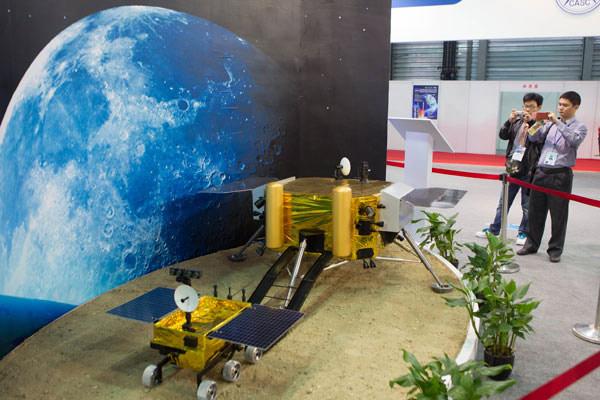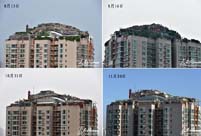 |
| A model of the Chang'e-3 lunar rover is on display at an exposition in Shanghai this month. Wu Zhijian, spokesman for the State Administration of Science, Technology and Industry for National Defense, said at a news conference on Tuesday that the Chang-e' 3 lunar probe will be launched in early December. The soft lunar landing will be the first by any country in 37 years. (China Daily/Gao Erqiang) |
BEIJING, Nov. 27 (Xinhuanet) -- China is counting down to the launch of its first lunar rover mission, which will blast off early next month.
While final touches are being put on the Chang'e-3 spacecraft and its carrier rocket, scientists cautioned that the voyage to the moon is risky.
"More than 80 percent of the technology adopted in the mission is new, and with new technology and products carrying out new tasks, there are certainly great risks," said Li Benzheng, deputy commander in chief of the lunar exploration program.
The mission represents the first time China has attempted a soft landing on a celestial body, and also the first time any lunar soft landing has been carried out since 1976, when other countries suspended exploration, Li said on Tuesday in Beijing.
After touching down on the moon's surface, the unmanned craft will unleash its roving vehicle, dubbed Yutu, or "jade rabbit" in Chinese. In folklore, a white rabbit was the pet of moon goddess Chang'e. The modern version will roam the moon's surface to learn more about Earth's satellite, he said.
"It could be a trying process for the rover to move down the lander," Li told Tuesday's news conference.
The Chang'e-3 mission is the second phase of China's lunar program, which includes orbiting, landing and returning to Earth. It follows the success of the Chang'e-1 and Chang'e-2 missions in 2007 and 2010. The country expects to have an unmanned spacecraft return with lunar samples by 2020.
Although the previous duo laid the foundation for the current mission, Chinese scientists still have limited knowledge of the moon, Li said.
Of the 129 lunar explorations conducted by various countries, 49 percent failed, Li said, citing his agency's analysis.
"This indicates that explorations do, indeed, carry significant risks," he said.
To ensure the success of this mission, tracking and control networks have been set up in areas including China's northwestern Xinjiang Uygur autonomous region and northeastern Heilongjiang province. Their capabilities are close to the current world standard, Li said.
"The Chang'e-3 mission makes best use of a plethora of innovative technology. It is an extremely difficult mission that carries great risk," Ma Xingrui, chief commander of the lunar program, told Xinhua News Agency in September.
Chinese scientists have built an experimental landing site in Beijing to test the functions of the lander, and they have simulated moon-surface locomotion of the rover, Li said.
"We have conducted large numbers of tests in each stage to avoid perils, and have contingency plans based on these tests, ... but after all, it's our soft-landing on the moon, so there are certain risks."
At the news conference, Li congratulated India on its recent successful launch of a mission to Mars — its first. He said China is not competing with any other country, but it is interested in peaceful advancements.
Pang Zhihao, executive editor-in-chief of the monthly publication Space International, said China's lunar rover must overcome many dangers and difficulties for it to "survive and operate" after landing in Sinus Iridum, or the Bay of Rainbows, on the moon's surface.
The moon's wide temperature range — from more than 100 C during the day to as low as -150 C at night — presents just one of many challenges. To work properly, the rover needs to maintain an internal operating temperature range of -40 to 50 C, Pang said.
"The temperature-control system is crucial for the operation of the solar-powered rover," he said.
In fact, nuclear power will be used during the night to maintain the rover's temperature in the correct range, he said.
Wang Ya'nan, deputy editor-in-chief at Aerospace Knowledge magazine, was enthusiastic.
"The Chang'e-3 mission will definitely become one of the most important and magnificent events in humanity's exploration of the moon since the United States landed its astronauts more than 40 years ago," Wang said.
Wu Yanqin, a professor of astronomy at the University of Toronto, said the new mission was a big step beyond the orbiters China has sent to circle the moon.
"I am impressed with the fact that this mission is equipped with a telescope to observe the sky. This is remarkable given the many other technical hurdles that had to be overcome. If the telescope can successfully operate, it will be a world record," Wu said.
Abraham Loeb, chair of the Astronomy Department at Harvard University, said the landing site for China's Chang'e-3 moon lander is in the vicinity of the Laplace A crater, which measures 8 km in diameter. In the distant past, material ejected from deep in the crater ended up near the crater's rim and can tell a story about the moon's composition.
The rover, equipped with four cameras, will patrol the surface for at least three months. If it explores the edge of the crater, it will identify material that originated deep below the surface and provide new clues about the moon's history, Loeb said.
"The lander will open a new age in space exploration by China," he said.
Zhao Lei contributed to this story.
 Finland has more eggs in the Chinese basket than any other
Finland has more eggs in the Chinese basket than any other In pictures: PLA's digital equipment
In pictures: PLA's digital equipment  Protesters demonstrate during UN Climate Change Conference in Poland
Protesters demonstrate during UN Climate Change Conference in Poland  Self-made farmer billionaire donates 69 villas at hometown
Self-made farmer billionaire donates 69 villas at hometown Demolition of bizarre rooftop villa in Beijing still in progress
Demolition of bizarre rooftop villa in Beijing still in progress Service seminar for E China train attendants
Service seminar for E China train attendants  Supermodel-turned-designer
Supermodel-turned-designer Cheerleaders light up CBA regular season
Cheerleaders light up CBA regular season  Finland--anytime you want is right time to go: Ambassador
Finland--anytime you want is right time to go: Ambassador Maritime counter-terrorism drill
Maritime counter-terrorism drill Splendid views of cities blanketed with fog
Splendid views of cities blanketed with fog  Models dazzle at Int'l Yacht Model Pageant
Models dazzle at Int'l Yacht Model Pageant  How to apply for a green card in China
How to apply for a green card in China Annual Santa Claus parade held in Canada's Montreal
Annual Santa Claus parade held in Canada's Montreal Weekly Sports Photos
Weekly Sports PhotosDay|Week|Month